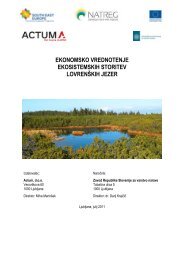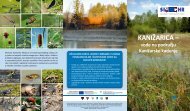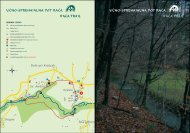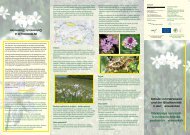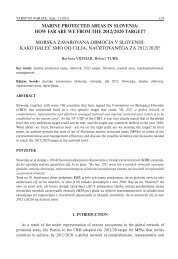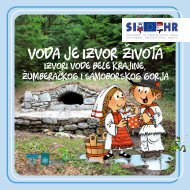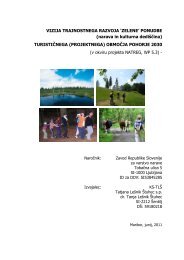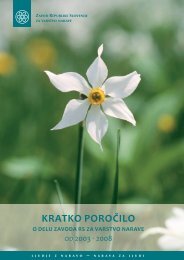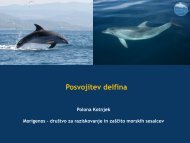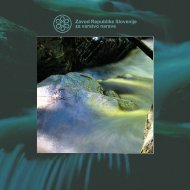Monitoring MPA visitor uses handbook
Monitoring MPA visitor uses handbook
Monitoring MPA visitor uses handbook
- No tags were found...
You also want an ePaper? Increase the reach of your titles
YUMPU automatically turns print PDFs into web optimized ePapers that Google loves.
1.2 Scientific cooperation and guidedevelopment process1.2.1 Request by the MedPAN NordprojectManagers today have recurring needs and high expectationsfor addressing the issue of human use of their<strong>MPA</strong>s. There are four major ca<strong>uses</strong> at the root of themanagement difficulties encountered :• the Mediterranean is a world-leading region for tourism;• the region's <strong>MPA</strong>s face major pressure from tourist useand the stakes are high;• local entities tend to have limited financial resources;• manager expertise in <strong>visitor</strong> use monitoring is relativelyunderdeveloped on the whole.1.2.2 The experience of LETG Géomerand Port-Cros National Park (France)The geographic research laboratory LETG Brest Géomer(UMR 6554 CNRS) initiated scientific work on theobservation and monitoring of <strong>visitor</strong> use in coastal,marine and island areas in 1995. In the Mediterraneanarea, LETG Brest Géomer began developing original<strong>visitor</strong> use monitoring methods in 2001 in cooperationwith Port-Cros National Park (France). The National Parkhas had a <strong>visitor</strong> monitoring observatory, named Bountîles,since 2003. The observatory is a pioneering achievementin French <strong>MPA</strong>s, allowing quantitative and qualitativevariations in the main recreational activities (diving,walking, boating) to be monitored.1.2.3 From the seminar to the guideFor several years now, action taken with Port-CrosNational Park has aroused interest beyond local boundaries.In 2007, Géomer conducted a study (within theframework of the INTERREG IIIC MedPAN programme),to do the groundwork for an initial transfer of knowledgedeveloped in Port-Cros to the other MedPAN network<strong>MPA</strong>s.The knowledge transfer process continued moreconcretely from 6 to 8 June 2011, at a seminar organisedby the MedPAN Nord project, attended by 11 <strong>MPA</strong>management entities, the LETG Géomer scientists andWWF-France, the project coordinator.During the seminar, managers reported a great varietyof experiments and raised many questions concerningmethods and techniques. The presentations they gavehighlighted the varying degrees of experience in the studyand management of human activities. A shared needfor <strong>visitor</strong> use monitoring tools thus emerged: tools thatare easy to use, scientifically validated, and adaptable tothe diversity of <strong>MPA</strong>s in the Mediterranean.Participating <strong>MPA</strong>sLes Calanques de Marseille National Park (France)Cap de Creus Natural Park (Spain)Port-Cros National Park (France)Taza National Park (Algeria)El Estrecho Natural Park (Spain)Montgri, Medes Islands and Baix Ter Natural Park(Spain)Côte Vermeille Marine Nature Park (France)Strunjan Nature Reserve (Slovenia)Debeli rtiç Natural Monument (Slovenia)Marine Protected Areas managed by Epasa (Turkey)Cap d’Agde Natura 2000 marine site (France)Other entitiesLETG Géomer Brest (UMR 6554 CNRS),geographic research laboratoryParcs nationaux de FranceWWF-FranceTable 1 : List of organisations participating in the seminar on "Visitor usemonitoring in Mediterranean <strong>MPA</strong>s", 6 to 8 June 2011, Cap d’Agde (France).Define the <strong>visitor</strong> use study strategyImplement the <strong>visitor</strong> use studyTowards appropriatemanagementDefine the objectivesand resourcesDetermine the <strong>MPA</strong>characteristicsSelect and adaptindicatorsImplementthe indicatorsStore andprocess dataReport and sharethe resultsFigure 2 : Steps in the method proposed by the guide for the <strong>visitor</strong> use study. TABLE OF CONTENTS 10 COLLECTION VISITOR USE OBSERVATION AND MONITORING IN MEDITERRANEAN MARINE PROTECTED AREAS



